While buying a car there are a lot of words that are thrown around and someone who doesn’t have a lot of experience buying cars or dealing with them might feel a bit overwhelmed. In this blog, we will talk about everything related to car coating types and cover three major types of car coating and see which one is better. Ceramic coating Vs Teflon coating Vs Paint Protection Film. This will be a big one so strap in.
Amplify your brand presence with high-quality ads on GoMechanic Platforms. Click Here!
Let’s save your time. Watch the video to know the difference between ceramic coating and paint protection film.
What is car coating?
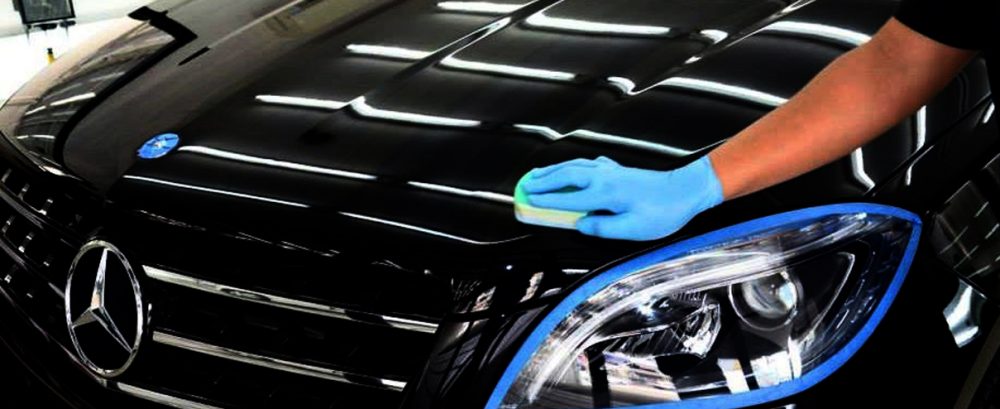
A stock car that comes from a factory has a simple paint job done it which is not bad in and of itself however it’s not durable. To make it more durable and make the car look elegant car coating is performed. It’s in layman terms just another coat of paint on the already present one but more durable and better looking. We will cover how and why it is better than the normal one and why we don’t get it by default.
Why Do You Need To Coat Your Car?
Don’t you want your car to look gorgeous? The shine that she had the first day when you got her. You want that to remain forever. Well unfortunately with only the stock paint that shine will go away even before you drive the car back home. Coating adds a layer on top of the paint and is durable enough to take punishments while still shining like a star.
You must be wondering that I can achieve that shine with just some intense cleaning sessions not even considering waxing which lasts a while. True indeed however no amount of wax or rubbing scrubbing will mitigate the damage your car takes daily. Everything on the road affects the paint on your car negatively from the rain to kids randomly selecting your car for today’s episode of which car gets a new scratch across its length.
To prevent all of this a simple coating can go a long way. None of us wants to see our car dirty or roughed up and that’s were coating it helps a ton.
The Science Behind Car Coating
How can coating achieve something which the normal paint fails to do? The reasoning behind it is science. Worry not for we will explain how coating works and why is it effective and out of the many options which one should you choose. But to make an educated decision we need to be educated on the topic of how coating works and in what ways Teflon, ceramic and PPF are different from each other.
Each coating has different reasoning behind its working and we will discuss them at length separately in their respective sections. Right now we will talk about what they have in common.
Every coating is applied on top of the car paint. This makes it so the car essentially has a second skin on top of it. This second skin is more durable, beautiful and better in every way possible compared to stock paint. The method of the coating sticking to paint is different for each case. This is the basics behind the science. Granted there was not a lot of science in it but it will get interesting later on.
Ceramic Coating

If you follow cars casually and/or have friends that are motorheads you must already be familiar with the term ceramic coating. It the new craze in town and everyone seems to want a taste of it. Here we will discuss is it worth the hype and if it is any good on the claims that the companies that sell the product make.
What Is Ceramic Coating?
Its a layer on top of your already existing car paint which sacrifices itself to ensure the paint stays clean and unharmed. It comes in a small bottle of 30 ml( yes 30 I didn’t miss a 0 there) and is all that is needed. There must be two questions on your mind right now how come a bottle of 30ml liquid will cover my entire car and how is it better than my paint coated car which takes litres. Let’s begin to uncover how ceramic coating works and what makes it so strong and reliable.
Science Behind Ceramic Coating
Ceramic coating is hydrophobic. That means it has an innate ability to repel water away from the surface. This makes it so no liquid can stick to the surface of your car. How does it do that? Let’s find out
The Lotus Effect
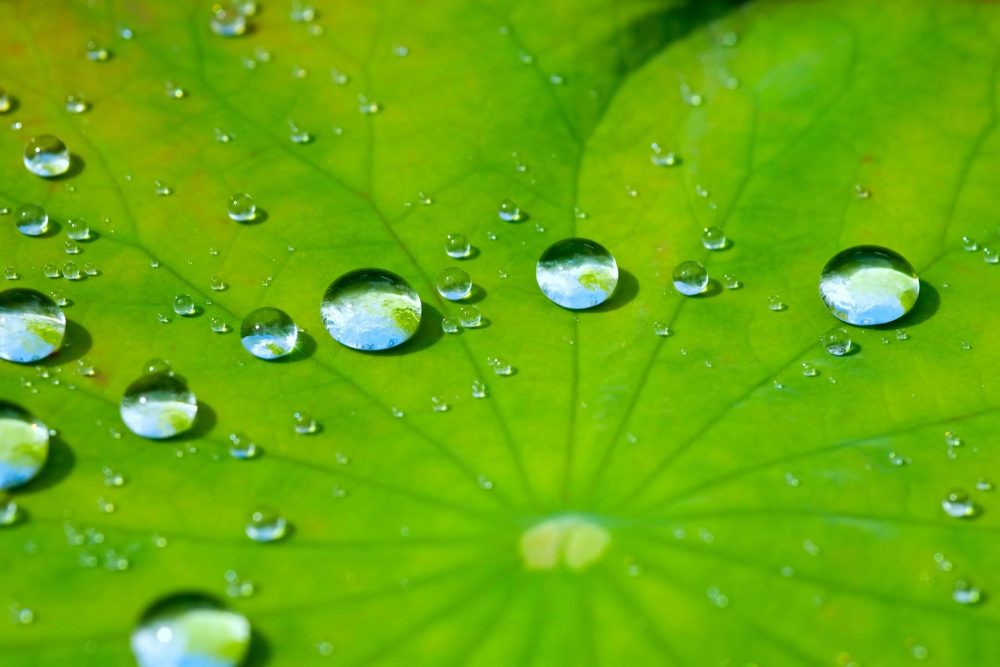
We all know water has a tendency to stick to a surface and make it wet. We know one more thing if the surface is slanted water will not stick to it. I’m sure you understand where this is going.
The lotus effect is named as such because on the surface of the leaves of a lotus that water never sticks instead forms droplets. This is because microscopically the surface of a lotus is not straight but tilted to an angle. This causes the water to form droplets and roll off the leaves.
Why Droplets and how does it help us?
Its because a sphere has the lowest surface tension of any shape thus allowing the water to not falter. A circular shape is the easiest to move because it can just roll and water being a droplet due to the lotus effect it can roll smoothly.
How Does Ceramic Coating Use The Lotus Effect
When the ceramic coating is applied it creates a layer over the paint which has an angle of over 120 degrees. This causes the water to make droplets to stay on the surface, however, the angle is too steep for it and after forming a droplet it just slides down with absolutely no friction because of the lower surface tension of the spherical shape. Being so costly and taking really long to apply on a car there must be other things that it helps with because if it only helps with water it is kind of not useful at all
What Can The Ceramic Coating Repeal
As we already discussed at length above that ceramic protects from water by sliding it off there are a few more things that it can protect your car paint from. It makes your paint resistant to UV, is strong enough to avoid scratches, doesn’t falter when chemicals are used on the paint, makes sure extreme heat doesn’t scrape the paint off and even anti-graffiti by having the ability to easily clean anything off of it. Speaking of easy cleaning, there is one more thing ceramic coating claims to do, it says that you’ll never need to wash your car. How true is that? Let’s find that out below.
Never Need To wash Your Car?
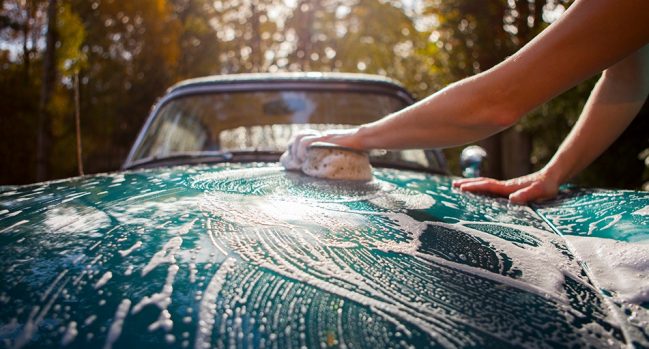
Companies that sell ceramic coating claims that after you apply it you won’t ever need to clean your car. A bit of an exaggeration but it is true to a certain extent. Throwing dirty water on a car with half coated and half non coated clearly shows that ceramic is superior and has no water retention making it Easier to clean.
Now that the working is out of the way lets try to justify why does it cost so much which if you don’t know it costs a lot.
Suggested Read: Car Wrapping | The Best Alternative For Car Painting
Cost Of Ceramic Coating Justified?
Short answer, Yes. Thanks for joining folks see you all next week. Now that the obligatory ‘joke’ in the middle of a big article is done let’s go forward and discuss why. And to discuss why we need to understand yet one more thing what are the steps undertaken to apply a ceramic coating on your car
Steps Undertaken To Apply Ceramic Coating
Step 1
After you submit your car to the workshop the first step is a car wash. And not an ordinary car wash. This has to be a thorough cleaning from top to bottom with every nook and cranny covered and not even a single place can be left unclean as the ceramic coating will lock it in place and it will be stuck forever. Most dealerships use a ph balanced soap as a bit too much on the acidic or basic side and it will eat through your paint. This step alone takes hours to do giving you an idea behind the manpower spent on it
Step 2
Paint decontamination which involves using a product to literally dissolve any and all impurities that can withstand that cleaning session we talked about earlier. This mainly involves iron particles and tar off the road. The product is applied to the car and then is left to dwell for a period of 5-10 mins and is then rinsed off the car with some spray washing. After that, the car is lubricated with soap water and clay is rubbed off the entire body of the car. The clay helps to pick up any remaining dirt on the car and with this, the car has finally been completely cleaned
Step 3
Dent correction in which all of the dents in your car are located and fixed appropriately. This takes quite some time and is an optional step. If your car doesn’t have any dents this step is completely skipped saving you time and money.
Step 4
This step involves buffing the car. It is also a really long step as the work is done on a 2×2 surface until that surface is absolutely perfect. This step is also the most demanding. It involves the use of heavy compounds which generate a lot of heat and if not performed correctly this step will burn your paint out. To prevent this, workshops use a tool which helps them determine the thickness of the paint at various points allowing them to know how much pressure they can put on a certain area. As you can guess this step needs the hand of professionals and takes the most amount of time in ceramic coating job.
Step 5
Now the car goes to polishing. Similar to buffing, the polishing is done in 2×2 grids. In this step more freedom is present as polishing doesn’t generate that much heat which can destroy your paint.
Step 6

The actual Ceramic coating. 5 steps, it took 5 steps to reach the ceramic coating part which should give you an idea of why it costs so much. This step id not that complex per se. You just apply the liquid on top of your car and you’re done. It takes time for sure and has a very low margin of error.
So, Is It Worth It Or Not?
Now that we went through the steps involved to perform ceramic coating you should have an idea as to why it costs this much. There is one more question though. Can all of this be done DIY to cut costs on worker charges? Yes, it is possible. Should you do it? Absolutely not. Why do we judge your skills to ceramic coat even though we don’t know you? Because as good as you might be at something you’ll never beat a professional at it.
DIY or Professional Coating
If you still are wondering how to do a ceramic coating yourself we will help you with it, although the results may not be as good as a professional coating and it may even leave your car worse than what you started.
As you might have guessed for a DIY ceramic coating there will be way fewer steps compared to what a professional does as they have tools which are not accessible to us. This would be a lower quality coating. For DIY coating all you need is a bottle of the ceramic coat. A small 30ml bottle is enough for the entire car. Youll also need three microfiber wipes to help you with the application.
Another Read: Best Car Cleaning Products You Could Try: Top 6
How To Apply Ceramic Coating Yourself
We will now explain how to ceramic coat your car. As we have already discussed the cleaning process above well skip the major details here and just do a small refresher.
Step 1
Washing your car thoroughly. Even if it looks clean enough it won’t be enough. Use the two bucket wash method and thoroughly clean your car with a ph-balanced soap and water mixture. Use one of the three microfiber wipes to clean your car.
Step 2
Next step is to clean rock chips, iron particles and tar stuck on your car. Youll need a special compound for this. If you think that your car doesn’t have any of those things there is a cool trick we saw on the internet. Put a plastic bag over your hand and rub it along the length of your hood of the car. If you feel a rough sensation that means your car is contaminated with all the above-stated particles and they need to go before you can ceramic coat your car unless you want them permanently embedded in your car.
Step 3
The step on the ceramic coating. The bottle of the coating has a dipper with it that you can use. Three drops on a sponge then rub it on your car in a 2×2 grid. You have to be really fast for this step as you don’t want the coat to dry out. Out of the two microfiber wipes left you to need one a bit damp. First, use the dry wipe then use the damp to remove any excess coat. Do this over the entire car and you have a new ceramic coated car.
If you are confident in your ability to pull this off you now also have the knowledge to perform this. Do check what ceramic coating company is better for you as some of them are exclusive to workshops only and need things like paint correction done before they can be applied to the car.
Now that ceramic coating is discussed we move on to the second of three coatings. The Paint Protection Film
Paint Protection Films
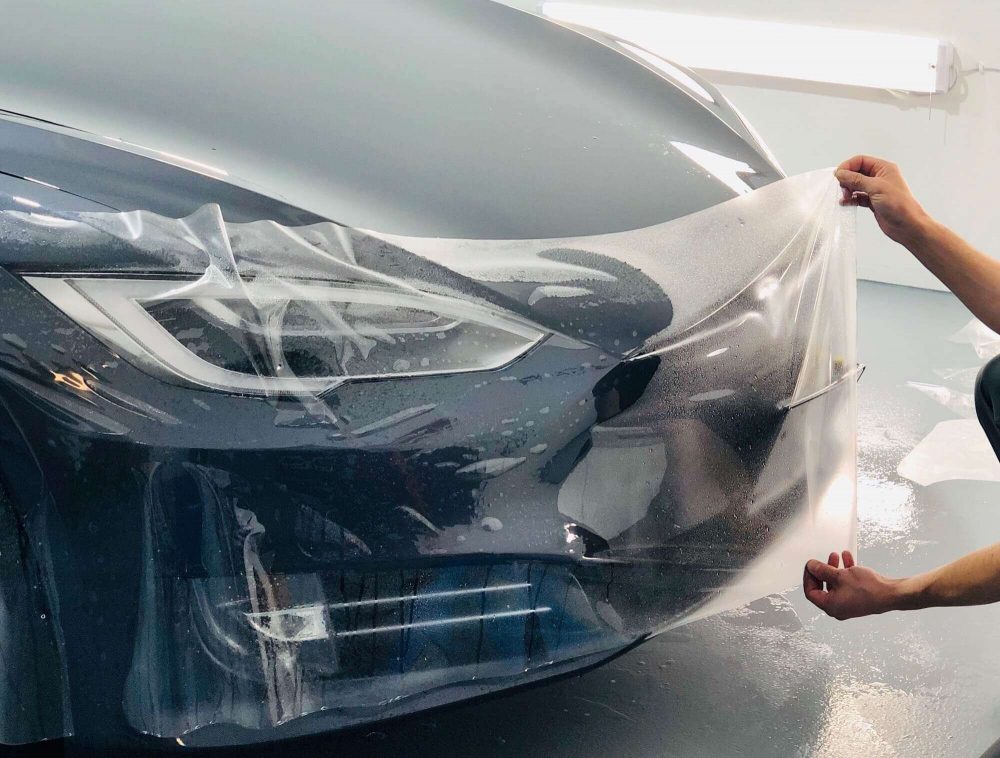
The paint Protection film is four layers of varying compounds making one PPF. It is a type of coating which is used for more protection than to get a good look of it. Not to say it won’t give your car a good look but as we read above, ceramic is the go-to if you want to go for some protection and more looks. Companies claim that PPF can heal any scratches put on it as long as they don’t harm the layer and break it. We will be checking those claims alter with the help of science and see if those are true or just hogwash. Let’s start by seeing what a PPF is made up of
What Is A PPF Made Up Of?
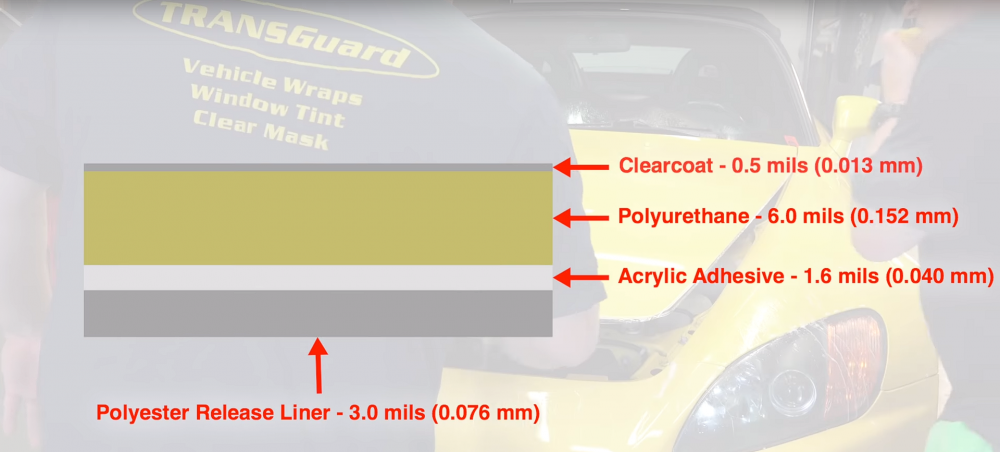
The polyester Release liner is there to prevent the Acrylic Adhesive from drying out or sticking to something not intended. Polyurethane is the shield that helps mitigate the damage which will discuss later while a thin layer of clear coat ensures the layer prior to it doesn’t get damaged by things like exhaust as the Polyurethane layers have pores in it which when filled with things like dirt and exhaust fumes will discolour the PPF making it look like your pain is old.
What Is Paint Protection Film?
Paint protection film involves covering the entire length of the car with a saran wrap. Not really a saran wrap but you get the gist. Unlike ceramic coating which involves a liquid rubbed across the entire length of the car, PPF involves wrapping the car with a specially made film. We will discuss at length how the film works, what it is made of and how it helps to protect the paint on your car.
Watch our Latest Video on GoMechanic Youtube
What does Paint Protection Film Help Against?
PPF is considered a really durable coating that can withstand a lot of punishment and is probably one the strongest ones out there. It can protect your car paint from a decent amount of damage varying from physical impacts like rock chips and scratches to chemicals like acid rain.
Paint protection film also claims to have the ability ‘heal scratches’. Is it the truth or just a lie to sell the product? Let’s discuss
Self Regenerating Car Coating?
If you are getting one done for your car the workshops throw terms like its a self-regenerating car coat which can heal its scratch. Is all of that true or just hot garbage. Turns out, it’s actually true. As long as the PPF doesn’t tear it will heal everything that is on it. Scratches? Delete them! some kids made some graffiti on your car? Erase them without rubbing off the paint. How does it do all of that we need science to answer that
The science behind Paint Protection Film
Damage Mitigation
Force dissipation. PPF uses force dissipation. What is that and how does it work? It’s a phenomenon which involves spreading the force around an area instead of keeping it in one point. Take for example a nail and a smooth rock. Push both of them with the same force into your hand the nail will hurt more because the area on the nail which is touching your hand is really small compared to the rock which has a huge area of contact. This means that if the force is applied to a small area it will affect more instead of the same force applied to a larger area. This is force dissipation. How does PPF use it? Before we get into that there is one more thing that PPF which is more astonishing to behold, the self-regeneration.
Self Healing
To understand self-regeneration we need to know one thing that physic teaches us. Everything in nature wants to go back to a stable state. A stable state is one where there is no excessive use of energy by the object thus called a stable state. PPF stable state is one where it doesn’t have any scratches and it will want to go back. How does it go back? We will discuss that later in the sperate part made for it. But first, we learn about force dissipation and how does it help PPF.
Force Dissipation To Save Your Car
Image a small rock hitting the side of your car, this would normally put a small chip in your paint. If you have the PPF however it will not even make an impact. Because of the force dissipation. But didn’t we just say dissipation will only happen if the object is big and doesn’t apply force on a small point? Yes but the beauty of PPF is that it dissipates the force that is applied on it completely negating any and all force that is applied on it. There is a limit to what it can take. Obviously it won’t be able to withstand really high damage and if there is a tear in PPF it will stop working.
How To Heal Your Car From Scratches ft PPF
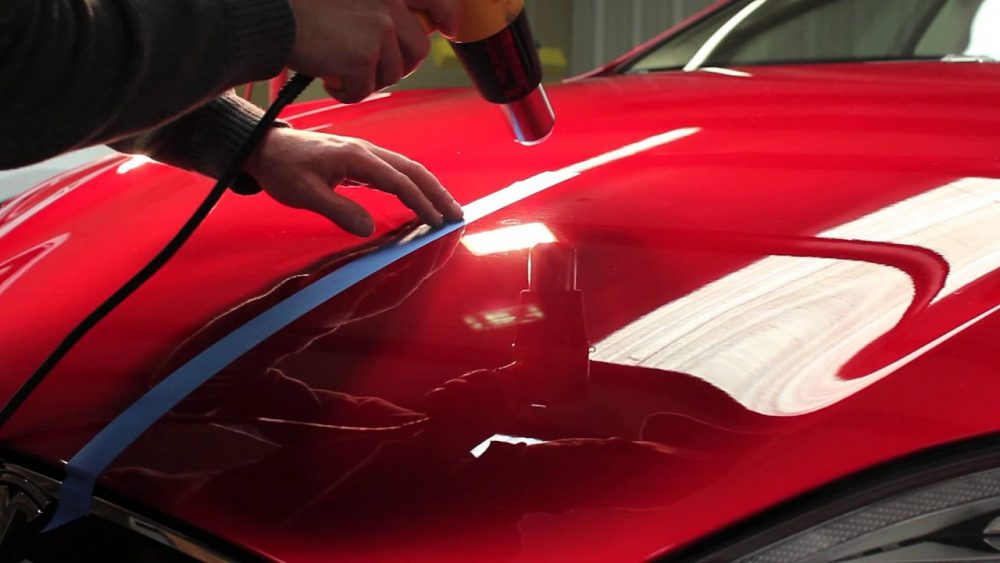
As we discussed above objects want to go to a stable state that they started with. But if that’s the case shouldn’t every object be just changing shapes left and right. Why does the mug you have in your cupboard doesn’t go back to its state? It because PPF isn’t most objects. If provided enough heat the object will revert back to its normal shape. The heat, in this case, is nominal. You can just pour hot water and the scratches will go away. It’s that easy! After your car is scratched just pour hot water on it and the scratches will go right off. It’s because the stable state of your PPF is the non-scratched state.
Now that we have seen how the claims that companies make are true, is PPF worth the cost?
Similar Read: Types Of Car Scratches And Repairs Explained | All You Need To Know
Is the Cost Of Paint Protection Film Justified?
Absolutely it does. It will save you ten times the amount you put it in to get it done and the work is done and resources put by the workshops it is worth it. How much work is put in it and what are the resources that are spent on it? Let’s discuss it step by step and see what work is put in and why it is so costly. To give you an estimate an average PPF costs 1.30 Lakhs INR.
How Is Paint Protection Film Applied?
Step 1
The first step involves cleaning the car thoroughly. This involves cleaning the car with soap and water and cleaning with microfibre cloths. Then a clay cleaning is done which involves running the entire length which sucks up everything dirty in the car and cleans it thoroughly.
Step 2
This is the step that takes the resources needed to pull this off. The PPF is not provided to the workshops in the car dimensions. Instead, they are given to them in a huge roll. To make it pit on the car the workshops need to design the car in software on a pc panel by panel and then is cut by a special printer which makes clean and precise cuts.
Step 3
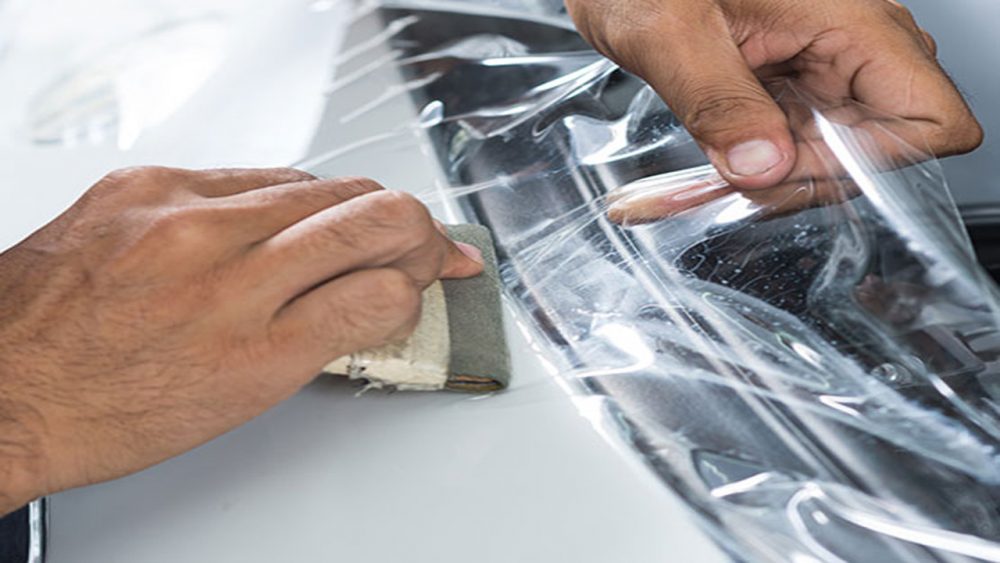
Remember the image on top? Not this one. the one that showed the layers of PPF. The layer on the bottom is removed to reveal the adhesive part. Before it is applied the car is sprayed with a mixture of soap and water. Then the film is applied on top of it but not sealed off. A mixture of alcohol is used to clean the soap and water mixture off the panel and then the film is attached carefully as to not leave any airgaps. This step as you can imagine takes a lot of work and is really intensive on the people performing it. This is also the final step.
Is It Worth It?
It might involve fewer steps compared to ceramic coating but it’s certainly more demanding and very well worth every rupee you spend on it. It also offers more protection compared to Ceramic coating. But, there is an interaction between them if you are willing to spend the cash.
The Fusion Of Beauty And Strength; Ceramic coating over PPF
Just as the title states you can put a ceramic coating over PPF. What the point of it you ask? PPF offers unrivalled protection and ceramic provides that glossy new paint looks on your car that we crave. It will cost a lot and it’s almost an overkill to get both. but if you got the cash why not do it anyway
DIY or Professional?
There is no question here. Professional 100%. You cant get the things needed to perform a coating anyways so there is no doubt. Even if you were somehow able to acquire the parts that we discussed above it is close to impossible for a person to PPF his/her car first try with no help from an experienced person. So for the sake of both yourself and your car, please don’t DIY PPF.
If PPF offers really high protection and Ceramic offers beauty what does Teflon Coating the final coating we need to discuss offers? Continue reading to find more about this.
Teflon Coating

Teflon is the product name of the compound Polytetrafluoroethylene( we will now refer to it as PTFE as quite frankly the name is too much of a pain to type and read). It was created by a company named Chemours. PTFE similar to Ceramic is hydrophobic and has one of the lowest coefficients of friction of known solids helping with the lotus effect we discussed earlier.
What Is Teflon Coating Made Up Of?
We touched on a bit earlier, the Teflon is made up of PTFE. PTFE being hydrophobic makes it a suitable option to use for use as a coat on a car.
Is it any durable? A bit yes but the main claim about Teflon is that it counters rusting and wear and tear of paint at high temperatures. Let’s talk about it a bit more.
What Does Teflon Coating Help Against?
Its main selling point is that it protects the car from rust and paint ear and tear at high temperature. Unlike the other two options, it can also be applied to the underbody which takes the most punishment. It claims to help from rock chips and slush that builds in the underbody causing damage and rust in the long run. Below we will discuss the science of these claims and if they are true or not
Science Behind Teflon Coating
Before we go into what makes Teflon coating works lets study how Teflon does what it does. We know that Teflon is used to make non-stick utensils. When used a non-stick utensil will never have anything stick to it. This makes it an ideal choice for amateurs in cooking food to learn without ruining the food. Now instead of a utensil, the Teflon is applied to the car and instead of food we have dirt and rust trying to stick to the car.

If Teflon is non-stick, how will it stick to the car in the first place? Chemistry will answer that. PTFE or Teflon is made up of Carbon and Fluorine. Organic chemistry tells us that Fluorine is a picky eater. It will only bond with other Fluorine or Carbon atoms and will resist any other atoms attempt to stick to it thus making it non stick. The Teflon coating done on the car sticks to it because of the carbon present in the car body. And will stick to the underbody because of the iron present.
As the Teflon is non-stick, it will not allow anything to stick to it be it the water being splashed on the car because on top of being non-stick it is also hydrophobic making it even better at repelling water. And a rubberised coat of Teflon has enough force dissipation to withstand damage from rock chips. So does it make a better option than both Ceramic and PPF? Before we make a conclusion about that we need to focus on how much Teflon costs and if it is justified or not.
Is The Cost Of Teflon Coating Justified
Teflon coating costs like both ceramic and PPF varies upon the car size. Teflon coating can go an upwards of 5k to 7k maximum. Compared to ceramic and PPF it is drastically cheaper but we would still need to go over if it is justified or not.
How Is Teflon Coating Applied
Step 1
As you might have guessed, cleaning the car. There are a bit more restrictions in the case of Teflon coating as you can have anything which is not Ph neutral to clean the car as it will react badly with the Teflon coating.
Step 2
Now the car is polished, this is because when the Teflon coating is applied it will retain the polishing of the car and will get a glossy look. You have to note that Teflon doesn’t have the glossy look on its own but retains the glow of the already present polish.
Step 3
Teflon coating is done in this final step. Similar to ceramic coating it comes in a small bottle and smells just as bad. The smell goes away after it dries on top of the car paint. Excess is cleaned away and now you have a car with Teflon coating.
Is It Worth It?
Not really, the thing is it’s just a cheaper option of both coatings combined and does half the job they do. The only upside when compared to the rest of coating options, is that it is cheaper. It doesn’t last long, provides weaker protection compared to PPF and less gloss compared to Ceramic. But if we are talking about it there must be some upsides to it, right? Yes, there are Teflon is not all that bad. It provides unrivalled rust protection in the underside of the car which the other coatings don’t.
DIY or Professional?
You can actually DIY Teflon coating at home as it is easier but you need to be a bit careful as to not to get any in moving parts as the rubberised compound will kill your car. You need to move your car to an enclosed space as to not get any new dirt or dust on it while you are applying the coat. And its fairly easy, almost similar to applying wax on your car.
Now that all of the coatings are discussed at length we can now go into which one is the best option from the three
Verdict; Teflon Vs Ceramic Vs Paint Protection Film
We will separate the options depending upon durability, cost-efficiency, looks and longevity. We will give points to all of them and tally the score at the end. The first choice gets 3 points, seconds gets two and the last gets one
Durability
PPF takes the lead here followed by Teflon then Ceramic. PPF should come to you as a no surprise however you might be a bit confused as to why Teflon is above ceramic. Ceramic only offers mild protection from rock chips and UV rays while Teflon does both of those things and also prevent rusting of car. If Teflon protects against rust shouldn’t it be above PPF as well? It’s because of the amount of protection PPF provides trumps protection against rust from Teflon. The ability to heal scratches is no joke.
Cost Efficiency
Ceramic wins here as it provides both protection and the glow for the price that it costs not even considering the amount of work put into it. PPF comes second with high durability but average looks. Last is Teflon with decent protection and just look retention from the wax applied.
Looks
Ceramic takes the spot again as it is the best looking of all three of them. Second is PPF even though it is not as good looking as ceramic or has as good of polish retention as Teflon it can be combined with ceramic to give it the same look. Last is again Teflon with no looks of its own just polish retention
Longevity
PPF takes the first spot as once applied it is safe for over 10 years. It can also withstand a lot of punishment and won’t be needing a replacement before its time. The second spot is ceramic which can last upwards of 5 years with last being Teflon which doesn’t even last a year.
Points
Paint Protection Film- 11
Ceramic Coating- 9
Teflon Coating-5
According to the criteria that we set up PPF takes the first spot and should be the first choice if you are considering getting one of the three options. And if you have the money to spend using Ceramic coating on top of a PPF will give you the best of both worlds.
Read More: Car Paint | Automotive Paints And Coatings | An Insight






This is the best article I have read so far on comparisons between PPF, Ceramic Coating and Teflon. The way you have explained trumps everything I had read on PPF so far. What are your views on the different brands of PPF available in the market, like Xpel, Saint-Gobain, 3M, Llumar etc.?
Can you please point me to a comparison article.
Nice information very well explained 😊
I prefer ceramic coating for mid range cars
And For premium and expensive cars PPF is best option.
Teflon is just Time Pass
👍👍
[…] Know the difference: Teflon Vs Ceramic Vs Paint Protection Film; Which One Is The Best? […]
Very nicely explained. I am a newbie on this and found this article so easy to follow.
Big thanks. Very detailed and explained clearly.
Very good article with just as much information without putting in lot of technical jargons so that any normal person can understand. The best article so far that I have come across comparing the car coatings available in market.
Is there any product available which will put a layer on side glass of car to protect from sun rays ?
We do have something you can check out. Take a look at our range of Best Car Accessories: https://gomechanic.in/accessories
my car (elantra n) came with a ceramic coating. 2 thousand miles later a pencil head size paint chip happened to my beautiful baby blue (hyundai calls it performance blue?)paint job. Was wondering if ppf coat could be applied over ceramic coat and would it take care of blemish? And then can you or should you put another ceramic coating over ppf or is this all overkill?
Hey David,
Applying PPF on a paint chip is not a good idea. A Paint Protection Wrap will only accentuate and highlight the paint deformation and bottom line; will look bad. Of course, you can put Ceramic Coating on a PPF (a speciality Ceramic Coating solution is readily available). That’ll be like added protection and peace of mind.
Nice education to protect a car
PPF price in India and where to get this done ?
Hey Vipul!
Please drop in your location and contact number for us to call you back!
Please Share PPF Details for New Delhi
Hey Nakul, please share your coontact and vehicle details on gomechanicblog@gomechanic.in and we’ll get an executive callback arranged for you asap!
Please Share PPF and Ceramic Coating Details for New Delhi
Hey Abhishek, kindly share your vehicle brand/model and contact details on gomechanicblog@gomechanic.in and we’ll get an executive callback for you with customised pricing.
Very well explained, thanks for the information